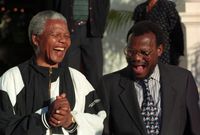
Today many South Africans believe “the ANC liberated us” from Apartheid, but, as is usually the case in history, the real story is a lot more complicated.
Whilst the ANC is one of the oldest surviving anti-Apartheid organisations, founded in 1912, it was not always the most important. An important group often left out of the ANC’s version of history is the Pan Africanist Congress (PAC) which broke away from the ANC in 1959, and became very influential and popular. The famous anti-pass march at Sharpeville on the 21st of March 1960, which resulted in the Apartheid police shooting dead 69 people, was actually organised by the PAC and not the ANC.
Another pivotal moment in the anti-apartheid struggle, the Soweto uprising, arose out of a protest against Afrikaans instruction in black schools, launched by the Black Consciousness Movement and its affiliated groups.
Not only was the ANC not the most important mover and shaker in organising protest, but it was also not the most popular. The Inkatha Freedom Party (IFP) founded in 1975 by Mangosuthu Buthelezi, was for a time one of the largest and most important anti-Apartheid groups within South Africa. A poll conducted in 1978 of black South Africans in Soweto showed that Buthelezi was supported by 43% of people, whilst Nelson Mandela enjoyed only 21% support in the same poll. The ANC only became the “big game in town” in the 1980s. However other anti-Apartheid groups remained popular and important into the 1990s.
Many people claim that life in SA has not gotten better since the democratic transition in 1994, but this is not true. Whilst poverty, crime and unemployment remain pervasive, South Africa has seen periods of major improvement between 1994 and 2021, mostly in the mid 2000s. The economy grew every single year between 1994 and 2007, with the growth rate being an impressive 5% in 2005, 2006, and 2007.
Between 1994 and 2008, the number of people living in shacks declined, the number of people with access to water and electricity increased, the number of employed people went up and serious crimes, like murder, decreased. This period coincides with the government’s GEAR policy, which embraced a more free market outlook. Unfortunately, after the 2008 financial crisis, government turned away from GEAR and progress began to stall. Today, in the aftermath of Covid-19, the government is doubling down on anti-growth ideas and South Africa is starting to seriously reverse the progress made since 1994.
Many politicians like to talk about South Africa as though it were a battleground between race groups. Some have even suggested that everything that has gone wrong started in 1652, when the Dutch first arrived to set up a victualling station at the Cape. The truth is much more complicated.
For many decades after settling at the Cape, white Europeans did not often travel very far into the interior due to unfamiliarity with the terrain, lack of incentives to explore, and disease. In the earlier days of the colonial settlement of South Africa, religion and language remained much more important dividing lines between South African people than race.
Dutch-speaking Christians lived very different lives from their Sotho and Nguni-speaking ancestor-worshiping neighbours. Even then, many settlers on the frontier of the colonies lived in a grey zone between these cultures, often adopting aspects of both. Other groups which would today be considered to be made primarily of “coloured” people, such as the Griquas, lived lives which blurred the line between African and European by combining both cultures. Many South Africans lived in a far more racially mixed world than many people today would assume.
It was only in the latter half of the 1800s that race was elevated to a status of importance by the colonial authorities. Driven by the European fads of “scientific racism” that swept the world in the latter half of the 19th century, colonial officials began to put many more explicit restrictions on people on the basis of their race, so that even black South Africans who were Christian and spoke European languages began to be excluded from society in a serious way. This discrimination only grew worse over time; after reaching its height in the middle years of Apartheid during the 1970s,it began to decline, with many Apartheid laws being repealed in the 1980s and the first all-race elections being held in 1994.
